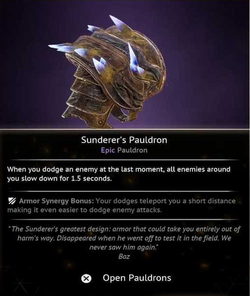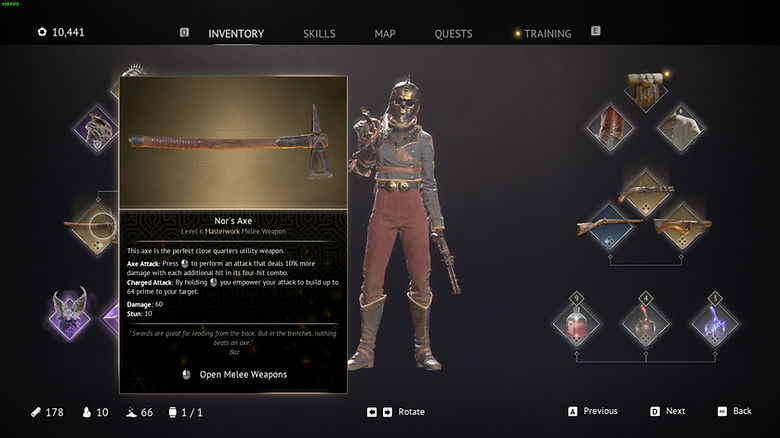

Trailer
Download
Gallery
 |  |
|---|---|
 |  |
 |  |
 |  |
 |  |
 |  |
Senior Game Designer
Overview
I joined the Flintlock: The Siege of Dawn team in mid-2022 and remained there until mid 2024 as their Senior Game Designer with a specialization in systems design. The game had been in development for ~3 years, so when I joined, I inherited all of systems from the previous and current Game Design team. A big part of my role involved designing and balancing new systems and features while also updating and balancing 3 year old systems.
I was hired for:
-
Combat Design
-
Economy Design
-
Mentoring Junior Game Designers
Combat Design
Armour System Design
I was tasked with designing a brand new combat system that would solve the issues of the current Armour system while also deepening the game's combat.
Old Armour System
The old Armour System was essentially one where players could obtain temporary buffs by defeating enemies in very specific ways that would increase the amount damage that players would deal and decrease the amount of damage players would receive.
The system made combat too difficult to balance because we wanted players to care and interact with this system. Otherwise why bother having it all? So in order to make it relevant, the extra damage dealt and reduced damage reduction had to be low enough. This resulted in us having to decide whether we balanced enemies with the player having the buff or not in mind.
If we balanced enemies for a buffed player in mind, then players would feel hopeless when they didn't have the buff. And if we balanced enemies for a non-buffed player in mind, then players wouldn't interact with the system and they would be overpowered with the buff. It wasn't ideal in either case.
It also forced players towards certain playstyles in order to obtain the buff even if they didn't want to and / or found those playstyles unenjoyable.
In the end, I settled on 3 different designs of varying scope (low, mid and high) to propose to the executive team. After much back and forth and compromise, the high scoped proposal was chosen - The Traditional Armour system while also completely scrapping the old system.
Traditional Armour System
This new system is a traditional armour system that gives players the opportunity to equip equipment pieces to 3 different slots (Helmet, Shoulder and Glove) that provides passive buffs and changes to existing abilities that when combined, could completely change gameplay and create new playstyles.
Each Armor piece belonged to a 3-piece set that would activate a powerful passive ability if 2 pieces from the same set were equipped. Giving players more freedom to customize their builds with slight adjustments to their build with the 3rd piece.
Out of the 5 Armour sets (15 equipments pieces) added to the game, I was responsible for designing 2 of the Armour sets - The Warlock set and the Sunderer's set. The Warlock set was my favourite because it created a long ranged playstyle in a melee combat game that was sorely lacking in the game without creating too much scope. It gave players who were weak at melee builds and / or enjoyed long ranged playstyles the opportunity to also enjoy the game as well.
In essence, this new design not only solved the problems that it set out to do, but it also enhanced other areas. Flintlock: The Siege of Dawn followed a wide-linear level design that had entire world with amazing combat encounters and hidden story beats, but players didn't have enough incentive to explore and experience these moments. This new Traditional Armour System created that incentive for combat-centric players because it now meant that every nook and cranny could reward players with a new Armour piece or material to upgrade Armour at the end of it.
Enemy Balance
As the only Systems Designer and the one with extensive experience in balancing an enemy's combat proficiency, I was tasked with rebalancing all enemies in the entire game. My only limitation was that I could only propose and make changes that didn't require additional or changes in animation, VFX or code.
I achieved this by:
-
Creating and maintaining a combat data spreadsheet that contained the following enemy data:
-
Enemy Health
-
Enemy Stun Health
-
Enemy Prime Health
-
Enemy Shield Health
-
Enemy Attacks
-
Enemy Attack Combos
-
Enemy Attack wind up, follow through and recovery frames
-
Enemy Attack Speed
-
Enemy Attack Tracking
- Enemy Aggression
- Enemy Attack Range
-
-
Used the spreadsheet to simulate and balance all enemies and their combat proficiency to fit the Lead Game Designer's intended combat difficulty curve
-
Entered the Enemy data into the Data Tables in Unreal Engine to reflect the spreadsheet numbers
-
Adjusted Enemy Attack hitboxes to accurately reflect the visual indicators
I wanted to play around with Enemy movement speed and attack readability, but that would have involved too much animation resources that were available at the time.
Elite Enemy Rebalance
Part of my Enemy Balance tasks also involved rebalancing all Elite Enemies. I took it upon myself to not only balance according to the Lead Game Designer's difficulty curve, but I also balanced with the goal of teaching players lessons and testing whether they actually learned these lessons.
The Stone Herald is the first difficult enemy that players encountered at the end of the first dungeon. My goal for this Elite Enemy was to test whether players had learned how to Parry enemy attacks yet.
Throughout the dungeon, players would have encountered enemies with predictable and forgiving attacks that ease players into the Parry mechanic. They would also spawn nearby if they made enough mistakes and died in combat, making the whole dungeon extra forgiving.
Players would be able to progress through the dungeon without Parrying, but they would progress through with much more ease if they made use of that skill. This is the same for the Stone Herald Elite Enemy at the end of the dungeon. This Elite Enemy encounter pushed players to master their Parry skill more because simply Blocking would result in their death because the Stone Herald's attack would completely break the player's Block because it was so powerful.
Dukmar Boss Redesign
Part of my Enemy Balance tasks also involved rebalancing all Bosses. But I was also tasked with redesigning the Dukmar boss encounter to make it more fun and challenging with the same scoped down restrictions.
The original Dukmar encounter was very cinematic and slow, which unfortunately resulted in it being a bit dull compared to the game's other boss fights. Essentially, I achieved my goal of increasing the challenge and fun of Dukmar by:
-
Reducing the recovery frames of certain attacks in, giving players less time to react between attacks
-
Stitched existing attacks together to form +10 new combos, forcing players to learn more inputs and timings to successfully avoid attacks
-
Increased Dukmar's Movement Speed, giving players less time to react between attacks
-
Increased Dukmar's Blade Beams giving players less time to react to this attack
Player Progression Design
Economy Design
Flintlock: The Siege of Dawn's economy is tied directly to the player's combat progression systems because the main form of currency, Reputation is used to purchase all Items, upgrade all Armour Equipment pieces and unlock all Skills in the Talent Tree.
I was tasked with rebalancing the game's entire economy to follow the Lead Game Designer's difficulty curve.
I achieved this by:
-
Creating and maintaining an economy data spreadsheet that detailed:
-
How much Reputation each enemy dropped once defeated depending on how much effort was required to defeat them and what area these enemies spawn in
-
How much Reputation is required to purchase every Item
-
How much Reputation is required to upgrade every Armour Equipment piece
-
How much Reputation is required to unlock every Skill
-
How much your Reputation bonus increases by when you perform any of your Skills
-
-
Entered all of this economy spreadsheet data into Data Tables in Unreal Engine
-
Balanced the game's economy following the critical path. Due to the game's wide linear level design and soulslike mechanics, the amount of Reputation that players at the same point in the games' story could widely vary. I made sure that players who only followed the critical path would have access to what we wanted them to have access to to still possess the combat power to clear the game
Player Progression Balance
I was tasked with rebalancing the strength of all combat related powers associated with the player to follow the Lead Game Designer's intended difficulty curve. This included player Skills, Armour Abilities, Melee Weapons, Primary Firearms, Secondary Firearms, Grenades and Consumables
I achieved this by:
-
Created +100 mathematical damage formulas that determined exactly how and what player variables were taken into account to calculate damage dealt to enemies
-
Creating and maintaining a player combat data spreadsheet that detailed:
-
Damage stats
-
Defensive stats
-
Attack Range
-
Unique Armour Ability stats
-
Firearm Magazine Size
-
Bullet Spread
-
Grenade Explosion Radius
-
Grenade Explosion Time
-
Many many more...
-
Programs: Unreal Engine 4, Perforce, Confluence, Google Sheets, Miro



_svg.png)

 |  |
|---|---|
 |  |
 |  |








